The perilous journey of Carthaginian General Hannibal across the Alps during the Second Punic War is renowned not only for his military prowess but also for the valiant presence of his war elephants. However, a lingering question echoes through time: Where did these war elephants originate? Did they come from Asia or Africa?
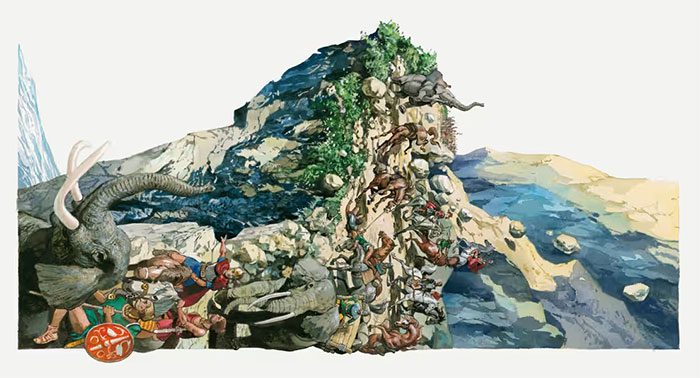
Illustration of Hannibal crossing the Alps with elephants and horses. (Image: Getty Images).
Hannibal Barca is a name that resonates in the annals of ancient military history. He emerged as a formidable Carthaginian general during the Second Punic War, which lasted from 218 to 201 BC. Renowned for his outstanding strategic skills and bold military tactics, Hannibal’s legacy is perhaps most clearly marked by his audacious use of war elephants in his campaigns. This tactic later became a timeless example of overcoming adversity.
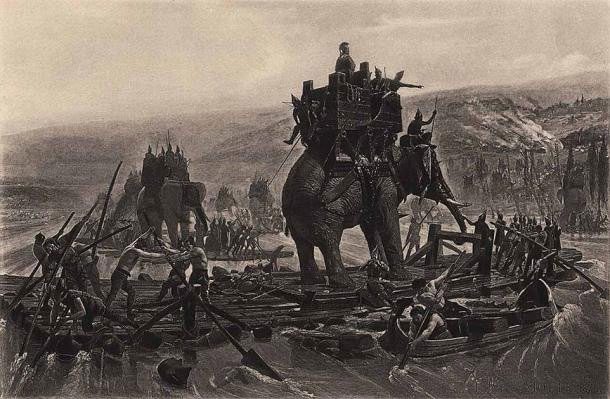
Hannibal’s army with war elephants crossing the Rhône River. (Image: Public domain).
Unique and Bold Military Strategy
Around 218 BC, Hannibal embarked on a daring mission to unite with allies against Rome. He led a powerful army of 100,000 soldiers and 40 war elephants. The decision to incorporate war elephants into his military strategy was both bold and revolutionary, showcasing Hannibal’s creative and unique command abilities.
The journey across the Alps was a significant challenge due to harsh conditions, claiming the lives of many soldiers and war elephants.
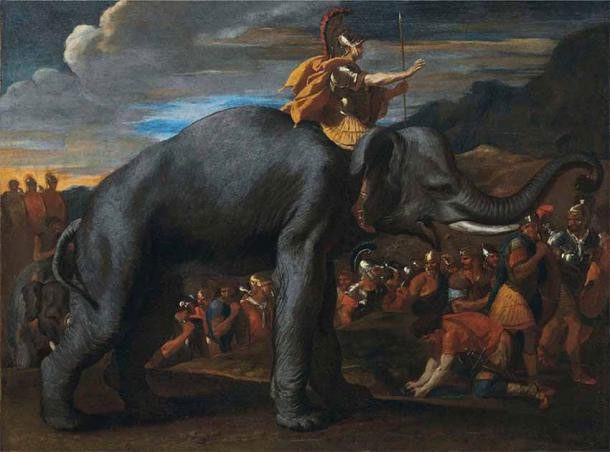
Hannibal crossing the Alps on the back of an elephant. (Image: Public domain).
However, despite these hardships, Hannibal’s successful crossing of the Alps stands as a testament to his genius military capabilities. The image of war elephants traversing treacherous passes left an indelible mark on the minds of contemporaries and future generations. Hannibal’s elephants became symbols of boldness, determination, and the readiness to employ unique methods to achieve strategic objectives.
The importance of Hannibal’s elephants was not only in their tactical capabilities; these colossal creatures also served as living siege engines, instilling fear in the hearts of opposing forces. Their enormous size disrupted enemy formations, granting Hannibal significant advantages on the battlefield.
Where Did Hannibal’s Elephants Really Come From?
While the crossing of the Alps is an incredible journey that solidified Hannibal’s status as one of history’s greatest military leaders, many mysterious aspects of the journey have been analyzed but never resolved. One of the greatest mysteries is the origin of the war elephants that Hannibal used.
War elephants have a long history of military use. However, the exact origins of Hannibal’s elephant force remain undetermined. During Hannibal’s time, only two species of elephants existed – Asian and African. To this day, it has not been established whether Hannibal used Asian elephants, African elephants, or a combination of both.
Arguments For and Against Hannibal Using African War Elephants
While many believe Hannibal may have preferred Asian elephants due to their smaller size and easier trainability, arguments supporting the use of African elephants highlight the challenges in controlling these massive creatures. With their smaller stature, Asian elephants do not seem to be the perfect choice for large-scale battles.
The difficulty of training and directing elephants is a crucial issue for any military commander. Traditionally, it is believed that African elephants, known for their independent nature, could pose significant challenges on the battlefield. However, this view has been criticized as some experts argue that African elephants are actually harder to train than Asian elephants.
According to Professor Graeme Cumming from the University of Western Australia: “It is a mistake to assume that African elephants cannot be trained. In the eyes of experts, training an elephant depends on the temperament of the individual, the handler’s expertise, and the training methods used, not the species of the elephant. The larger size of African elephants makes them appear more intimidating than Asian elephants.”
While both species can be trained, Asian elephants are considered more manageable due to their smaller size. Many viewpoints suggest that the larger size of African elephants is not more suitable for military purposes and would make it difficult for them to move easily through the treacherous Alps.
Could Hannibal’s Elephants Be a Subspecies of African Forest Elephants?
Many historians speculate that Hannibal’s elephants may have come from a subspecies of forest elephants residing in the Atlas Mountains of Morocco and Algeria. These elephants, standing a modest 8 feet (about 2.4 meters) at the shoulder, differ significantly from the larger elephants found elsewhere in Africa.
In a paper published in The New York Times, Gavin de Beer from the Natural History Museum in the 1950s provided insights into this elephant species. He emphasized the potential challenges associated with their temperament. Furthermore, their dangerous temperament during attacks, as de Beer noted, could add to the difficulty of training them effectively in a military context.
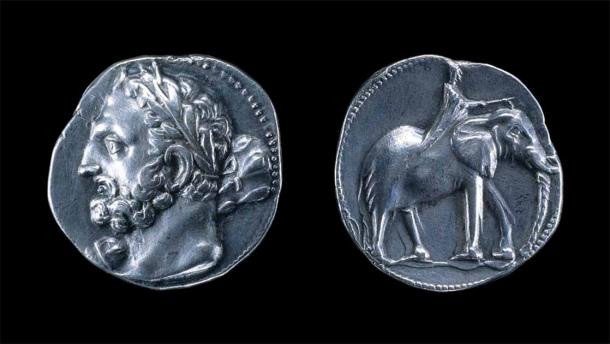
The two shekel silver coin of Carthage, depicting Hannibal riding a war elephant. (Image: The British Museum).
Coincidentally, a coin dating back to Hannibal’s time features an image of an elephant, which may provide visual evidence of the presence of African elephants in his army. The depiction on the coin may align with the characteristics of smaller forest subspecies, adding historical nuance to the ongoing debate about Hannibal’s strategic choices.
Was Surus an Asian Elephant?
Some historians assert that tales of Surus, the war elephant believed to be the only survivor from Hannibal’s military campaign, provide evidence that Hannibal’s elephants may have been of Asian origin.
The name “Surus” suggests a connection to Syria, indicating that it is highly likely that the elephants were captured during Egyptian campaigns in Syria. These elephants may have been brought back to Carthage and added to Hannibal’s formidable elephant army.
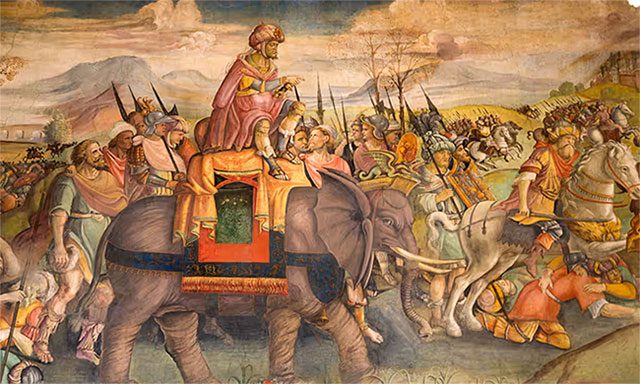
Painting of Hannibal and his army at the Capitoline Museum, Rome. (Image: Alamy).
While Surus provides compelling evidence of the presence of Asian elephants in Hannibal’s elephant army, this does not confirm that all of Hannibal’s elephants originated from Asia.
The speculation that Surus may descend from elephants acquired during Egyptian campaigns hints at the possibility that Hannibal sourced elephants from various regions, creating a diverse elephant force to bolster his military strength.
The Puzzle of Hannibal’s Elephants’ Origins
In reality, we may never be certain about the origins of Hannibal’s elephants. As large creatures requiring substantial amounts of food, capable of moving and bearing heavy loads in complex terrain, it is likely that Hannibal had a very careful plan in place.
Therefore, it is possible that Hannibal was less concerned about where his elephants came from and more focused on whether they had the enduring strength necessary for his forces in the Second Punic War.
The discovery of a bone fragment in September 2023 in southern Spain has yielded no answers. On one hand, the bone is believed to possibly belong to an elephant used by either Hannibal or Julius Caesar’s army.
On the other hand, an article in El País reported that Rafael Martínez, a zoologist from the University of Córdoba, concluded after examining the bone: “It is very difficult to determine whether the elephant species is from Asia (Elephas maximus) or Africa (Loxodonta africana)”.




















































